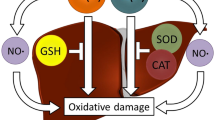Abstract
Although copper has been demonstrated to promote lipid peroxidation in a number of systems, the mechanisms involved have not been fully defined. In this study, the role of copper in modifying lipid peroxidation has been explored in rat hepatic microsomes. In an in vitro system containing reduced glutathione (GSH, 200 μM) and Tris buffer, pH 7,4, cupric sulfate (1–50 μM) potentiated lipid peroxidation induced by ferrous sulfate (10 μM) but was unable to elicit peroxidation in the absence of iron. Higher levels of cupric sulfate (100 μM or greater) were inhibitory. The nature as well as the extent of the peroxidative response of microsomes to cupric sulfate were dependent on glutathione levels in addition to those of iron. Cupric sulfate (100 μM) strongly potentiated ferrous ion-induced lipid peroxidation in the presence of 400–800 μM GSH, while it inhibited peroxidation at lower levels of GSH (0–200 μM) and did not affect ferrous ion-induced peroxidation with glutathione levels of 3–10 mM.
The potentiating effect of copper on ferrous ion-induced lipid peroxidation was further explored by investigating: (1) potential GSH-mediated reduction of cupric ions; (2) potential copper/GSH-mediated reduction of ferric ions (formed by oxidation during incubation); and (3) possible promotion of propagation reactions by copper/GSH. Our results indicate that cupric ions are reduced by GSH and thus are converted from an inhibitor to an enhancer of iron-induced lipid peroxidation. Cuprous ions appear to potentiate lipid peroxidation by reduction of ferric ions, rather than by promoting propagation reactions. Iron (in a specific Fe+2/Fe+3 ratio) is then an effective promoter of initiation reactions.
Similar content being viewed by others
Abbreviations
- ADP:
-
adenosine 5′-diphosphate
- GSH:
-
reduced glutathione
- SOD:
-
superoxide dismutase
- TBA:
-
2-thiobarbituric acid
References
Svingen, B.A., O’Neal, F.O., and Aust, S.D. (1978)Photochem. Photobiol. 28, 803–810.
Svingen, B.A., Buege, J.A., O’Neal, F.O., and Aust, S.D. (1979)J. Biol. Chem. 254, 5892–5899.
Hochstein, P., Kumar, S., and Forman, S.J. (1980)Ann. N.Y. Acad. Sci. 355, 240–246.
Ding, A.H., and Chan, P.C. (1984)Lipids 19, 278–284.
Wittig, M., and Steffen, C. (1984)Res. Commun. Chem. Pathol. Pharmacol. 44, 477–492.
Lowry, O.H., Rosenbrough, N.J., Farr, A.L., and Randall, R.J. (1951)J. Biol. Chem. 193, 265–285.
Eskola, J., and Laakso, S. (1983)Biochim. Biophys. Acta 751, 305–311.
Hamberg, M., and Samuelsson, B. (1967)J. Biol. Chem. 242, 5344–5354.
Mihara, M., Uchiyama, M., and Fukuzawa, K. (1980)Biochem. Med. 23, 302–311.
Yagi, K. (1984) inMethods of Enzymology (Packer, L., ed.) Vol. 105, pp. 328–331, Academic Press, New York.
Kumar, K.S., Rowse, C., and Hochstein, H. (1978)Biochem. Biophys. Res. Commun. 83, 587–592.
Tien, M., Morehouse, L.A., Bucher, J.R., and Aust, S.D. (1982)Arch. Biochem. Biophys. 218, 450–458.
Pederson, T.C., Buege, J.A., and Aust, S.D. (1973)J. Biol. Chem. 248, 7134–7141.
Tien, M., Bucher, J.R., and Aust, S.D. (1982)Biochem. Biophys. Res. Commun. 107, 279–285.
Braughler, J.M., Duncan, L.A., and Chase, R.L. (1986)J. Biol. Chem. 261, 10282–10289.
Bucher, J.R., Tien, M., and Aust, S.D. (1983)Biochem. Biophys. Res. Commun. 111, 777–784.
Minotti, G., and Aust, S.D. (1986)J. Biol. Chem. 262, 1098–1104.
Hill, K.E., and Burk, R.F. (1984)Biochem. Pharmacol. 33, 1065–1068.
Ursini, F., Maiorino, M., Valente, M., Ferri, L., and Gregolin, C. (1982)Biochim. Biophys. Acta 710, 197–211.
Gibson, D.D., Hornbrook, K.R., and McCay, P.B. (1980)Biochim. Biophys. Acta 620, 572–582.
Tan, K.H., Meyer, D.J., Belin, J., and Ketterer, B. (1984)Biochem. J. 220, 243–252.
Gutteridge, J.M., and Wilkins, S. (1983)Biochim. Biophys. Acta 759, 38–41.
Gutteridge, J.M.C., Hill, C., and Blake, D.R. (1984)Clini. Chimica. Acta 139, 85–90.
Steveninck, J.V., Van der Zee, J., and Dubbelman, T.M.AR. (1985)Biochem. J. 232, 309–311.
Gutteridge, J.M.C. (1982)FEBS. Lett. 150, 454–462.
McPhail, D.B., and Goodman, B.A. (1984)Biochem. J. 221, 559–560.
Author information
Authors and Affiliations
About this article
Cite this article
Beckman, J.K., Borowitz, S.M., Greene, H.L. et al. Promotion of iron-induced rat liver microsomal lipid peroxidation by copper. Lipids 23, 559–563 (1988). https://doi.org/10.1007/BF02535597
Received:
Issue Date:
DOI: https://doi.org/10.1007/BF02535597




